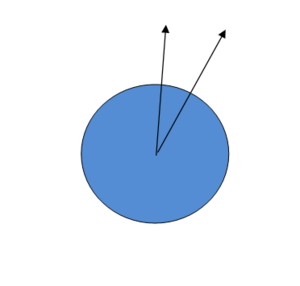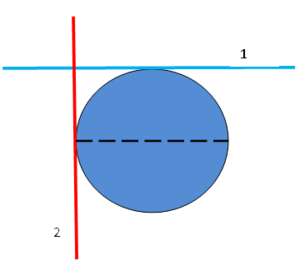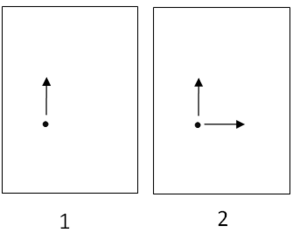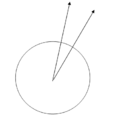Vertical and horizontal facts for kids
In astronomy and geography, a direction or flat surface is called vertical if it points towards or away from the center of gravity at that spot. Think of it as going straight up or straight down.
On the other hand, a direction or flat surface is called horizontal if it is perfectly flat and level. It is always at a right angle (90 degrees) to the vertical direction. Imagine a calm lake surface; that's horizontal. In a Cartesian coordinate system, the Y-axis is usually vertical, and the X-axis is horizontal.
Contents
What Do Vertical and Horizontal Mean?
Words from the Past
The word horizontal comes from the Latin word horizon. This word means 'separating' or 'marking a boundary'. It's like the line where the sky meets the Earth.
The word vertical comes from the Latin word verticalis. This is related to vertex, which means 'highest point'. Think of the very top of your head!
In 1636, a person named Girard Desargues wrote a book. He said that vertical means being at a right angle to the horizon.
Finding Vertical and Horizontal
Tools for Being Level
In building and engineering, we often need to find what is truly vertical or horizontal.
- A plumb-bob is a simple tool. It's a weight on a string. When it hangs freely, the string points exactly vertical. This is because gravity pulls it straight down.
- A spirit level uses a bubble in liquid. The bubble always floats to the highest point. If the bubble is in the middle, the surface is horizontal.
- A water level also helps find horizontal lines. It uses water, which always finds its own level.
- Modern laser levels are very accurate. They use lasers and can level themselves automatically. They work on the same basic ideas.
Earth's Curved Surface
When we think about the Earth, things get a bit more interesting. The Earth is a round ball, not a flat surface.
- If you drop a plumb-bob anywhere on Earth, it points towards the Earth's center. This means that two vertical lines, even if they are close, are not perfectly parallel. They will eventually meet at the Earth's center!
- This is important for big buildings like suspension bridges. The tops of the towers are actually a tiny bit farther apart than their bases. This is because they are both pointing towards the Earth's center.
- Also, flat horizontal surfaces can cross each other. Imagine a flat surface at the North Pole. Now imagine another flat surface at the equator. These two flat surfaces are both horizontal in their own places, but they cross each other at a right angle!
- So, a flat surface can be horizontal in one place and vertical in another. For example, the flat surface of the equator is horizontal for someone standing there. But for someone at the North Pole, that same flat surface is vertical!
More About Earth's Gravity
The Earth is not a perfect, smooth ball. It's a bit lumpy and spins.
- Because the Earth spins, a plumb-bob doesn't always point exactly to the center of the Earth. It only does this at the North and South Poles and at the equator.
- Also, the Earth's gravity field isn't perfectly even. Mountains or very dense rock can slightly pull a plumb-bob to the side.
- Even the Moon and Sun can slightly change the direction of gravity. This means the horizontal plane can change a tiny bit over time, like with the tides.
How Motions Work Together
When you throw a ball, its horizontal (sideways) motion and vertical (up and down) motion usually don't affect each other.
- For example, if you throw a ball straight up, it goes up and comes down. If you throw it forward, it also goes up and comes down, but it moves forward too. The time it takes to go up and down is the same in both cases. This idea was first explored by Galileo Galilei.
- However, this is only true if we ignore the Earth's curve. If you throw something very, very far, the Earth's curve matters. A projectile fired horizontally might actually leave the Earth's surface!
Vertical and Horizontal in Math
In Two Dimensions
Imagine a flat piece of paper with a Cartesian coordinate system on it.
- We usually call the up-and-down direction the Y-axis. This is our vertical direction.
- The side-to-side direction is the X-axis. This is our horizontal direction.
- You can choose which one to call vertical first. The other one will then be at a right angle to it.
- On a flat surface, through any point, there is only one vertical line and only one horizontal line.
- All horizontal lines are parallel to each other. All vertical lines are parallel to each other.
In Three Dimensions
When we add a third dimension, things change.
- Imagine a point in space. You can pick one direction as vertical.
- A flat surface that goes through that point and is at a right angle to the vertical direction is a horizontal plane. There is only one horizontal plane at that point.
- But there can be many vertical planes that go through that point. Think of a door. It's a vertical plane. You can have many doors (planes) rotating around a vertical line (like a door hinge).
In the Classroom
Sometimes, the way we use "vertical" and "horizontal" in math class can be confusing.
- When your teacher draws a Y-axis on a whiteboard, it really is vertical, like a plumb-bob.
- But if you draw a Y-axis on a piece of paper lying on your desk, that Y-axis is actually horizontal! This can be a bit tricky to remember.
Thinking About Horizontal
The idea of "horizontal" seems simple, but it has some interesting parts.
- The idea of horizontal only makes sense where there's a clear pull of gravity, like near a planet. In deep space, where gravity is very weak, "horizontal" doesn't really mean anything.
- A flat surface is only truly horizontal at a specific point. If you have two horizontal surfaces at different places, they are not parallel; they will cross each other.
- So, "horizontal" and "vertical" are local ideas. They depend on where you are.
Horizontal in Daily Life
Even though the scientific definition of horizontal can be complex, in our daily lives, it's usually simple.
- This is because the places we live and work are very small compared to the size of the Earth. So, the Earth seems flat to us, and nearby horizontal surfaces seem parallel.
- When we draw or use graph paper, we often say "horizontal" for the side-to-side direction (like the X-axis). This is just a common way to do it, even if the paper is lying flat on a table.
See also
- Cartesian coordinate system
- Coordinate system
- Horizon
- Local tangent plane
- Tilted plane
- Zenith
Images for kids








